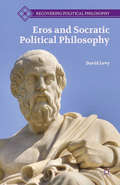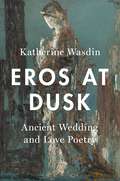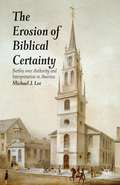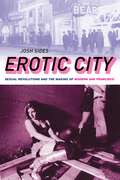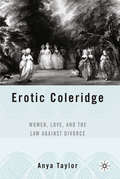- Table View
- List View
Eroïca: The Quest for Oil in Indonesia (1850-1898)
by J.P. PoleyA tribute to the pioneers of oil exploration in Indonesia (1850-1898). Using authentic reports, diaries, relevant texts, personal notes and pictures, Poley brings to life the heroic efforts of Reerink (Cheribon, W. Java), Zijlker and Kessler (Deli, NE Sumatra), Stoop (Surabaya and Rembang, E Java), Menten (Kutei, E Kalimantan), Kessler and IJzerman (Palembang, SE Sumatra), and their crews. They faced almost insurmountable odds in many locations: an impenetrable, cruel jungle, an inclement climate, tropical diseases, technical mishaps, financial restrictions, and, last but not least, government and legal constraints. There was no geological science to guide them, and drilling technology was still in its infancy. Yet it was their vision and perseverance which finally put Indonesia on the world map of oil-producing nations, and which contributed materially to the development of today's life of luxury. Much of the present text and several of the pictures are here presented for the first time to the general public.
Eros: The Myth Of Ancient Greek Sexuality
by Bruce S ThorntonEros: The Myth of Ancient Greek Sexuality is a controversial book that lays bare the meanings Greeks gave to sex. Contrary to the romantic idealization of sex dominating our culture, the Greeks saw eros as a powerful force of nature, potentially dangerous, and in need of control by society: Eros the Destroyer, not Cupid the Insipid, fired the Greek imagination.The destructiveness of eros can be seen in Greek imagery and metaphor, and in the Greeks' attitudes toward women and homosexuals. Images of love as fire, disease, storms, insanity, and violence?Top 40 song clich�for us?locate eros among the unpredictable and deadly forces of nature. The beautiful Aphrodite embodies the alluring danger of sex, while femmes fatales like Pandora and Helen represent the risky charms of female sexuality. And homosexuality typifies for the Greeks the frightening power of an indiscriminate appetite that threatens the stability of culture itself.In Eros: The Myth of Ancient Greek Sexuality, Bruce Thornton offers a uniquely sweeping and comprehensive account of ancient sexuality free of currently fashionable theoretical jargon and pretentions. In its conclusions the book challenges the distortions of much recent scholarship on Greek sexuality. And throughout it links the wary attitudes of the Greeks to our present-day concerns about love, sex, and family. What we see, finally, are the origins of some of our own views as well as a vision of sexuality that is perhaps more honest and mature than our own dangerous illusions.
Eros: The Myth Of Ancient Greek Sexuality
by Bruce S ThorntonEros: The Myth of Ancient Greek Sexuality is a controversial book that lays bare the meanings Greeks gave to sex. Contrary to the romantic idealization of sex dominating our culture, the Greeks saw eros as a powerful force of nature, potentially dangerous and in need of control by society: Eros the Destroyer, not Cupid the Insipid, is what fired the Greek imagination. The destructiveness of eros can be seen in Greek imagery and metaphor, and in their attitudes toward women and homosexuals. Images of love as fire, disease, storms, insanity, and violence—top 40 song clichés for us—locate eros among the unpredictable and deadly forces of nature. The beautiful Aphrodite embodies the alluring danger of sex, and femmes fatales like Pandora and Helen represent the risky charms of female sexuality. And homosexuality typifies for the Greeks the frightening power of an indiscriminate appetite that threatens the stability of culture itself. In Eros: The Myth of Ancient Greek Seualily, Bruce Thornton offers a uniquely sweeping and comprehensive account of ancient sexuality free of currently fashionable theoretical jargon and pretensions. In its conclusions the book challenges the distortions of much recent scholarship on Greek sexuality. And throughout it links the wary attitudes of the Greeks to our present-day concerns about love, sex, and family. What we see, finally, are the origins of some of our own views as well as a vision of sexuality that is perhaps more honest and mature than our own dangerous illusions.
Eros and Greek Athletics
by Thomas F. ScanlonAncient Greek athletics offer us a clear window on many important aspects of ancient culture, some of which have distinct parallels with modern sports and their place in our society. Ancient athletics were closely connected with religion, the formation of young men and women in their gender roles, and the construction of sexuality. Eros was, from one perspective, a major god of the gymnasium where homoerotic liaisons reinforced the traditional hierarchies of Greek culture. But Eros in the athletic sphere was also a symbol of life-affirming friendship and even of political freedom in the face of tyranny. Greek athletic culture was not so much a field of dreams as a field of desire, where fervent competition for honor was balanced by cooperation for common social goals. Eros and Greek Athletics is the first in-depth study of Greek body culture as manifest in its athletics, sexuality, and gender formation. In this comprehensive overview, Thomas F. Scanlon explores when and how athletics was linked with religion, upbringing, gender, sexuality, and social values in an evolution from Homer until the Roman period. Scanlon shows that males and females made different uses of the same contests, that pederasty and athletic nudity were fostered by an athletic revolution beginning in the late seventh century B.C., and that public athletic festivals may be seen as quasi-dramatic performances of the human tension between desire and death. Accessibly written and full of insights that will challenge long-held assumptions about ancient sport, Eros and Greek Athletics will appeal to readers interested in ancient and modern sports, religion, sexuality, and gender studies.
Eros and Inwardness in Vienna: Weininger, Musil, Doderer
by David S. LuftAlthough we usually think of the intellectual legacy of twentieth-century Vienna as synonymous with Sigmund Freud and his psychoanalytic theories, other prominent writers from Vienna were also radically reconceiving sexuality and gender. In this probing new study, David Luft recovers the work of three such writers: Otto Weininger, Robert Musil, and Heimito von Doderer. His account emphasizes the distinctive intellectual world of liberal Vienna, especially the impact of Schopenhauer and Nietzsche in this highly scientific intellectual world. According to Luft, Otto Weininger viewed human beings as bisexual and applied this theme to issues of creativity and morality. Robert Musil developed a creative ethics that was closely related to his open, flexible view of sexuality and gender. And Heimito von Doderer portrayed his own sexual obsessions as a way of understanding the power of total ideologies, including his own attraction to National Socialism. For Luft, the significance of these three writers lies in their understandings of eros and inwardness and in the roles that both play in ethical experience and the formation of meaningful relations to the world-a process that continues to engage artists, writers, and thinkers today. Eros and Inwardness in Vienna will profoundly reshape our understanding of Vienna's intellectual history. It will be important for anyone interested in Austrian or German history, literature, or philosophy.
Eros and Inwardness in Vienna: Weininger, Musil, Doderer
by David S. LuftAlthough we usually think of the intellectual legacy of twentieth-century Vienna as synonymous with Sigmund Freud and his psychoanalytic theories, other prominent writers from Vienna were also radically reconceiving sexuality and gender. In this probing new study, David Luft recovers the work of three such writers: Otto Weininger, Robert Musil, and Heimito von Doderer. His account emphasizes the distinctive intellectual world of liberal Vienna, especially the impact of Schopenhauer and Nietzsche in this highly scientific intellectual world. According to Luft, Otto Weininger viewed human beings as bisexual and applied this theme to issues of creativity and morality. Robert Musil developed a creative ethics that was closely related to his open, flexible view of sexuality and gender. And Heimito von Doderer portrayed his own sexual obsessions as a way of understanding the power of total ideologies, including his own attraction to National Socialism. For Luft, the significance of these three writers lies in their understandings of eros and inwardness and in the roles that both play in ethical experience and the formation of meaningful relations to the world-a process that continues to engage artists, writers, and thinkers today. Eros and Inwardness in Vienna will profoundly reshape our understanding of Vienna's intellectual history. It will be important for anyone interested in Austrian or German history, literature, or philosophy.
Eros and Socratic Political Philosophy (Recovering Political Philosophy)
by D. LevyEros and Socratic Political Philosophy offers a new account of Plato's view of eros, or romantic love, by focusing on a question which has vexed many scholars: why does Plato's Socrates praise eros highly on some occasions but also criticize it harshly on others? Through detailed analyses of Plato's Republic, Phaedrus, and Symposium, Levy shows how, despite the apparent tensions between Socrates' statements about eros in each dialogue, these statements supplement each other well and serve to clarify Socrates' understanding of the complex relationship between eros, religious belief, and philosophy. Thus, Levy's interpretation sheds new light not only on Plato's view of eros, but also on his view of piety and philosophy, challenging common assumptions about the erotic nature of Socratic philosophy. This novel approach to classic political theory will incite discussion and interest among scholars of classics, philosophy, and political theory.
Eros at Dusk: Ancient Wedding and Love Poetry
by Katherine WasdinThis book analyzes the relationship between wedding poetry and love poetry in the classical world. By treating both Greek and Latin texts, it offers an innovative and wide-ranging discussion of the poetic representation of social occasions. The discourses associated with weddings and love affairs both foreground ideas of persuasion and praise even though they differ dramatically in their participants and their outcomes. Furthermore, these texts make it clear that the brief, idealized, and eroticized moment of the wedding stands in contrast to the long-lasting and harmonious agreement of the marriage. At times, these genres share traditional forms of erotic persuasion, but at other points, one genre purposefully alludes to the other to make a bride seem like a paramour or a paramour like a bride. Explicit divergences remind the audience of the different trajectories of the wedding, which will hopefully transition into a stable marriage, and the love affair, which is unlikely to endure with mutual affection. Important themes include the threshold; the evening star; plant and animal metaphors; heroic comparisons; reciprocity and the blessings of the gods; and sexual violence and persuasion. The consistency and durability of this intergeneric relationship demonstrates deep-seated conceptions of legitimate and illegitimate sexual relationships. By examining these two types of poetry in tandem, Eros at Dusk adds fresh insight into the social concerns and generic composition of these occasional poems.
Eros at Dusk: Ancient Wedding and Love Poetry
by Katherine WasdinThis book analyzes the relationship between wedding poetry and love poetry in the classical world. By treating both Greek and Latin texts, it offers an innovative and wide-ranging discussion of the poetic representation of social occasions. The discourses associated with weddings and love affairs both foreground ideas of persuasion and praise even though they differ dramatically in their participants and their outcomes. Furthermore, these texts make it clear that the brief, idealized, and eroticized moment of the wedding stands in contrast to the long-lasting and harmonious agreement of the marriage. At times, these genres share traditional forms of erotic persuasion, but at other points, one genre purposefully alludes to the other to make a bride seem like a paramour or a paramour like a bride. Explicit divergences remind the audience of the different trajectories of the wedding, which will hopefully transition into a stable marriage, and the love affair, which is unlikely to endure with mutual affection. Important themes include the threshold; the evening star; plant and animal metaphors; heroic comparisons; reciprocity and the blessings of the gods; and sexual violence and persuasion. The consistency and durability of this intergeneric relationship demonstrates deep-seated conceptions of legitimate and illegitimate sexual relationships. By examining these two types of poetry in tandem, Eros at Dusk adds fresh insight into the social concerns and generic composition of these occasional poems.
Eros in Neoplatonism and its Reception in Christian Philosophy: Exploring Love in Plotinus, Proclus and Dionysius the Areopagite
by Dimitrios A. VasilakisShowing the ontological importance of eros within the philosophical systems inspired by Plato, Dimitrios A. Vasilakis examines the notion of eros in key texts of the Neoplatonic philosophers, Plotinus, Proclus, and the Church Father, Dionysius the Areopagite.Outlining the divergences and convergences between the three brings forward the core idea of love as deficiency in Plotinus and charts how this is transformed into plenitude in Proclus and Dionysius. Does Proclus diverge from Plotinus in his hierarchical scheme of eros? Is the Dionysian hierarchy to be identified with Proclus' classification of love? By analysing The Enneads, III.5, the Commentary on the First Alcibiades and the Divine Names side by side, Vasilakis uses a wealth of modern scholarship, including contemporary Greek literature to explore these questions, tracing a clear historical line between the three seminal late antique thinkers.
Eros in Neoplatonism and its Reception in Christian Philosophy: Exploring Love in Plotinus, Proclus and Dionysius the Areopagite
by Dimitrios A. VasilakisShowing the ontological importance of eros within the philosophical systems inspired by Plato, Dimitrios A. Vasilakis examines the notion of eros in key texts of the Neoplatonic philosophers, Plotinus, Proclus, and the Church Father, Dionysius the Areopagite.Outlining the divergences and convergences between the three brings forward the core idea of love as deficiency in Plotinus and charts how this is transformed into plenitude in Proclus and Dionysius. Does Proclus diverge from Plotinus in his hierarchical scheme of eros? Is the Dionysian hierarchy to be identified with Proclus' classification of love? By analysing The Enneads, III.5, the Commentary on the First Alcibiades and the Divine Names side by side, Vasilakis uses a wealth of modern scholarship, including contemporary Greek literature to explore these questions, tracing a clear historical line between the three seminal late antique thinkers.
Eros the Bittersweet: An Essay
by Anne CarsonThe insights presented in the volume are many and wide-ranging, recognizably in tune with the subtlest modern discussions of desire (such as triangulation. or loving what others love), yet offering new solutions to old problems, like the proper interpretation of Plato's Phaedrus. On the frequently discussed effect of literacy on Greek civilization, the book offers a fresh view: it was no accident that the poets who invented Eros were also the first readers and writers of the Western literate tradition.Originally published in 1986.The Princeton Legacy Library uses the latest print-on-demand technology to again make available previously out-of-print books from the distinguished backlist of Princeton University Press. These editions preserve the original texts of these important books while presenting them in durable paperback and hardcover editions. The goal of the Princeton Legacy Library is to vastly increase access to the rich scholarly heritage found in the thousands of books published by Princeton University Press since its founding in 1905.
Eros the Bittersweet: An Essay
by Anne CarsonThe insights presented in the volume are many and wide-ranging, recognizably in tune with the subtlest modern discussions of desire (such as triangulation. or loving what others love), yet offering new solutions to old problems, like the proper interpretation of Plato's Phaedrus. On the frequently discussed effect of literacy on Greek civilization, the book offers a fresh view: it was no accident that the poets who invented Eros were also the first readers and writers of the Western literate tradition.Originally published in 1986.The Princeton Legacy Library uses the latest print-on-demand technology to again make available previously out-of-print books from the distinguished backlist of Princeton University Press. These editions preserve the original texts of these important books while presenting them in durable paperback and hardcover editions. The goal of the Princeton Legacy Library is to vastly increase access to the rich scholarly heritage found in the thousands of books published by Princeton University Press since its founding in 1905.
Eros the Bittersweet: An Essay (Princeton Legacy Library #440)
by Anne CarsonThe insights presented in the volume are many and wide-ranging, recognizably in tune with the subtlest modern discussions of desire (such as triangulation. or loving what others love), yet offering new solutions to old problems, like the proper interpretation of Plato's Phaedrus. On the frequently discussed effect of literacy on Greek civilization, the book offers a fresh view: it was no accident that the poets who invented Eros were also the first readers and writers of the Western literate tradition.Originally published in 1986.The Princeton Legacy Library uses the latest print-on-demand technology to again make available previously out-of-print books from the distinguished backlist of Princeton University Press. These editions preserve the original texts of these important books while presenting them in durable paperback and hardcover editions. The goal of the Princeton Legacy Library is to vastly increase access to the rich scholarly heritage found in the thousands of books published by Princeton University Press since its founding in 1905.
Eros the Bittersweet: An Essay (Princeton Legacy Library #440)
by Anne CarsonThe insights presented in the volume are many and wide-ranging, recognizably in tune with the subtlest modern discussions of desire (such as triangulation. or loving what others love), yet offering new solutions to old problems, like the proper interpretation of Plato's Phaedrus. On the frequently discussed effect of literacy on Greek civilization, the book offers a fresh view: it was no accident that the poets who invented Eros were also the first readers and writers of the Western literate tradition.Originally published in 1986.The Princeton Legacy Library uses the latest print-on-demand technology to again make available previously out-of-print books from the distinguished backlist of Princeton University Press. These editions preserve the original texts of these important books while presenting them in durable paperback and hardcover editions. The goal of the Princeton Legacy Library is to vastly increase access to the rich scholarly heritage found in the thousands of books published by Princeton University Press since its founding in 1905.
Eros the Bittersweet: An Essay (Princeton Classics #130)
by Anne CarsonNamed one of the 100 best nonfiction books of all time by the Modern LibraryAnne Carson’s remarkable first book about the paradoxical nature of romantic loveSince it was first published, Eros the Bittersweet, Anne Carson’s lyrical meditation on love in ancient Greek literature and philosophy, has established itself as a favorite among an unusually broad audience, including classicists, essayists, poets, and general readers. Beginning with the poet Sappho’s invention of the word “bittersweet” to describe Eros, Carson’s original and beautifully written book is a wide-ranging reflection on the conflicted nature of romantic love, which is both “miserable” and “one of the greatest pleasures we have.”
The Erosion of Biblical Certainty: Battles over Authority and Interpretation in America
by Michael J. LeeAccording to conventional wisdom, by the late 1800s, the image of Bible as a supernatural and infallible text crumbled in the eyes of intellectuals under the assaults of secularizing forces. This book corrects the narrative by arguing that in America, the road to skepticism had already been paved by the Scriptures' most able and ardent defenders.
Erotic City: Sexual Revolutions and the Making of Modern San Francisco
by Josh SidesSince the 1960s, San Francisco has been America's capital of sexual libertinism and a potent symbol in its culture wars. In this highly original book, Josh Sides explains how this happened, unearthing long-forgotten stories of the city's sexual revolutionaries, as well as the legions of longtime San Franciscans who tried to protect their vision of a moral metropolis. Erotic dancers, prostitutes, birth control advocates, pornographers, free lovers, and gay libbers transformed San Francisco's political landscape and its neighborhoods in ways seldom appreciated. But as sex radicals became more visible in the public spaces of the city, many San Franciscans reacted violently. The assassinations of Mayor George Moscone and Supervisor Harvey Milk were but the most brazen acts in a city caught up in a battle over morality. Ultimately, Sides argues, one cannot understand the evolution of postwar American cities without recognizing the profound role that sex has played. More broadly, one cannot understand modern American politics without taking into account the postwar transformation of San Francisco and other cities into both real and imagined repositories of unfettered sexual desire.
Erotic City: Sexual Revolutions and the Making of Modern San Francisco
by Josh SidesSince the 1960s, San Francisco has been America's capital of sexual libertinism and a potent symbol in its culture wars. In this highly original book, Josh Sides explains how this happened, unearthing long-forgotten stories of the city's sexual revolutionaries, as well as the legions of longtime San Franciscans who tried to protect their vision of a moral metropolis. Erotic dancers, prostitutes, birth control advocates, pornographers, free lovers, and gay libbers transformed San Francisco's political landscape and its neighborhoods in ways seldom appreciated. But as sex radicals became more visible in the public spaces of the city, many San Franciscans reacted violently. The assassinations of Mayor George Moscone and Supervisor Harvey Milk were but the most brazen acts in a city caught up in a battle over morality. Ultimately, Sides argues, one cannot understand the evolution of postwar American cities without recognizing the profound role that sex has played. More broadly, one cannot understand modern American politics without taking into account the postwar transformation of San Francisco and other cities into both real and imagined repositories of unfettered sexual desire.
The Erotic Cloth: Seduction and Fetishism in Textiles
by Alice Kettle Lesley MillarThrough their metaphorical and material qualities, textiles can be seductive, exciting, intimate and, at times, shocking and disquieting. This book is the first critical examination of the erotically charged relationship between the surface of the skin and the touch of cloth, exploring the ways in which textiles can seduce, conceal and reveal through their interactions with the body. From the beautiful cloth which is quietly suggestive, to bold expressions of deviant sexuality, cloth is a message carrier for both desiring and being desired. The drape, fold, touch and feel, the sound and look of cloth in motion, allow for the exploration of identity as a sensual, gendered or political experience. The book features contributions on the sensory rustle and drape of silk taffeta and the secret pleasures of embroidery, on fetishistic punk street-style and homoerotic intimacy in men's shirts on screen, and a new perspective on the role of cloth and skin in the classic film Blade Runner. In doing so, it interrogates experiences of cloth within social, historical, psychological and cultural contexts.Divided into four sections on representation, design, otherness and performance, The Erotic Cloth showcases a variety of debates that are at the heart of contemporary textile research, drawing on the fields of art, design, film, performance, culture and politics. Playful, provocative and beautifully illustrated with over 50 color images, it will appeal to students and scholars of textiles, fashion, gender, art and anthropology.
The Erotic Cloth: Seduction and Fetishism in Textiles
by Alice Kettle Lesley MillarThrough their metaphorical and material qualities, textiles can be seductive, exciting, intimate and, at times, shocking and disquieting. This book is the first critical examination of the erotically charged relationship between the surface of the skin and the touch of cloth, exploring the ways in which textiles can seduce, conceal and reveal through their interactions with the body. From the beautiful cloth which is quietly suggestive, to bold expressions of deviant sexuality, cloth is a message carrier for both desiring and being desired. The drape, fold, touch and feel, the sound and look of cloth in motion, allow for the exploration of identity as a sensual, gendered or political experience. The book features contributions on the sensory rustle and drape of silk taffeta and the secret pleasures of embroidery, on fetishistic punk street-style and homoerotic intimacy in men's shirts on screen, and a new perspective on the role of cloth and skin in the classic film Blade Runner. In doing so, it interrogates experiences of cloth within social, historical, psychological and cultural contexts.Divided into four sections on representation, design, otherness and performance, The Erotic Cloth showcases a variety of debates that are at the heart of contemporary textile research, drawing on the fields of art, design, film, performance, culture and politics. Playful, provocative and beautifully illustrated with over 50 color images, it will appeal to students and scholars of textiles, fashion, gender, art and anthropology.
Erotic Coleridge: Women, Love and the Law Against Divorce
by A. TaylorErotic Coleridge charts Coleridge's prolific creation of love poems from early flirtatious verse to poems about marital incompatibility, the blank faces of young women fearing for their reputations, the obliterating seductions of young women, the exaltation of falling in love, the spoken and sung voices of women, the pain of jealousy, and late meditations on how to live with the waning of love. In his prose he responds to Parliamentary debates about punishing adulteresses and gives advice about how marriage can warp the soul. In his sensual exuberance and his ethics of reverencing the individuality of other persons, Coleridge attends closely to the lives of women.
Erotic Discourse and Early English Religious Writing (The New Middle Ages)
by L. FarinaErotic Discourse and Early English Religious Writing discusses the role of sexuality in medieval devotional practice, looking in particular at religious writings circulating in England in the tenth to thirteenth centuries.
Erotic Exchanges: The World of Elite Prostitution in Eighteenth-Century Paris
by Nina KushnerIn Erotic Exchanges, Nina Kushner reveals the complex world of elite prostitution in eighteenth-century Paris—the demimonde—by focusing on the professional mistresses who dominated it. These dames entretenues exchanged sex, company, and sometimes even love for being "kept." Most of these women entered the profession unwillingly, either because they were desperate and could find no other means of support or because they were sold by family members to brothels or to particular men. A small but significant percentage of kept women, however, came from a theater subculture that actively supported elite prostitution. Kushner shows that in its business conventions, its moral codes, and even its sexual practices the demimonde was an integral part of contemporary Parisian culture. Kushner’s primary sources include thousands of folio pages of dossiers and other documents generated by the Paris police as they tracked the lives and careers of professional mistresses, reporting in meticulous, often lascivious, detail what these women and their clients did. Rather than reduce the history of sex work to the history of its regulation, Kushner interprets these materials in a way that unlocks these women’s own experiences. Kushner analyzes prostitution as a form of work, examines the contracts that governed relationships among patrons, mistresses, and madams, and explores the roles played by money, gifts, and—on occasion—love in making and breaking the bonds between women and men. This vivid and engaging book explores elite prostitution not only as a form of labor and as a kind of business but also as a chapter in the history of emotions, marriage, and the family.
Erotic Geographies in Ancient Greek Literature and Culture
by Kate GilhulyErotic Geographies in Ancient Greek Literature and Culture addresses the following question: how does a place "get a reputation?" The Athenians associated sexual behaviors with particular places and their inhabitants, and this book decodes the meaning of the sexualization of place and traces the repercussions of these projections. Focusing on Corinth, Sparta, and Lesbos, each section starts from the fact that there were comic joke words that made a verb out of a place name to communicate a sexual slur. Corinth was thought of as a hotbed of prostitution; Sparta was perceived as a hyper-masculine culture that made femininity a problem; Lesbos had varying historically determined connotations, but was always associated with uninhibited and adventurous sexuality. The cultural beliefs encoded in these sexualized stereotypes are unpacked. These findings are then applied to close readings, ultimately demonstrating how sensitivity to the erotics of place enables new interpretations of well-known texts. In the process of moving from individual word to culture to text, Erotic Geographies recovers a complex mode of identity construction illuminating the workings of the Athenian imaginary as well as the role of discourse in shaping subjectivity. Gilhuly brings together a deep engagement with the robust scholarly literature on sex and gender in Classics with the growing interest in cultural geography in a way that has never been done before.




